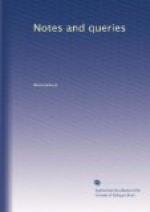Strewing Straw or Chaff.—The custom mentioned by your correspondent “B.” (p. 245.) as prevailing in Gloucestershire, is not peculiar to that county. In Kent, it is commonly practised by the rustics. The publican, all the world over, decorates his sign-board with a foaming can and pipes, to proclaim the entertainment to be found within. On the same principle, these rustics hang up their sign-board,—as one of them, with whom I was once remonstrating, most graphically explained to me. When they knew of a house where the master deems a little wholesome discipline necessary to ensure the obedience of love, considering it a pity that the world should be ignorant of his manly virtues, they strew “well threshed” chaff or straw before his door, as an emblematical sign-board, to proclaim that the sweet fare and “good entertainment” of a “well threshed” article may be found within. The custom, at all events, has one good tendency, it shames the tyrant into restraint, when he knows that his cowardly practices are patent to the world.
Lambert B. Larking.
* * * * *
FOLK LORE OF WALES.
No. 1. Cron Annwn.—When a storm sounds over the mountains, the Welsh peasant will tell you that his ear discerns the howl of the Cron Annwn mingling with that of the wind, yet as clearly distinct from it as is the atmosphere in a diving-bell from that of the surrounding waters. These dogs of Annwn, or “couriers of the air,” are spirit hounds, who hunt the souls of the dead; or, as occasionally said, they foretell, by their expectant cries, the approaching death of some man of evil deeds. Few have ever pretended to see them; for few, we presume, would linger until they dawned on the sight; but they are described by Taliesin, and in the Mabinogion, as being of a clear shining white, with red ears; colouring which confirms the author of the Mythology of the Ancient Druids in the idea that these dogs were “a mystical transformation of the Druids with their white robes and red tiaras.” Popular superstition, however, which must always attribute ugliness to an object of fear, deems that they are either jet black, with eyes and teeth of fire, or of a deep red, and dripping all over with gore. “The nearer,” says the Rev. Edmund Jones, “they are to a man, the less their voice is, and the farther the louder, sometimes swelling like the voice of a great hound, or a blood-hound.”
They are sometimes accompanied by a female fiend, called Malt y nos—Mathilda or Malen of the night, a somewhat ubiquitous character, with whom we meet under a complication of names and forms.




